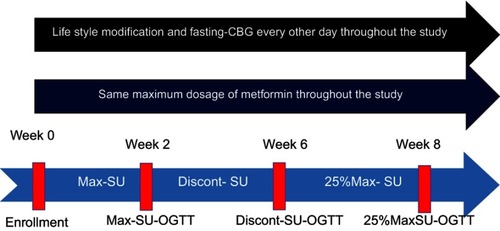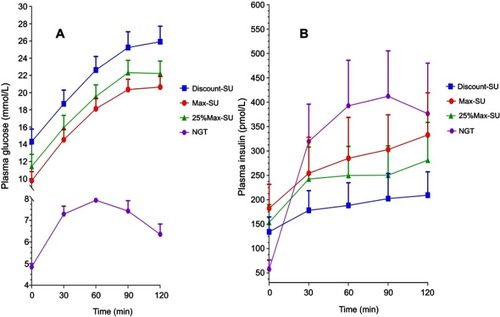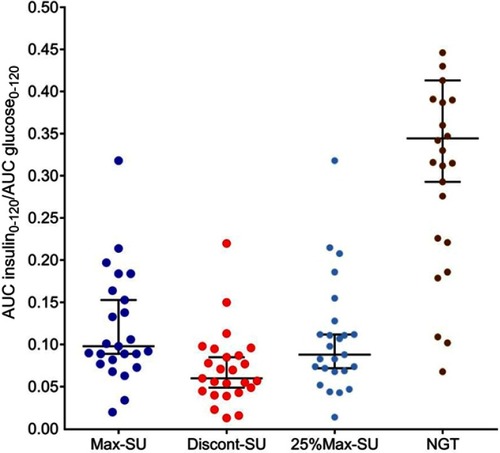Figures & data
Figure 1 Study protocol in type 2 diabetic patients who failed to maintain optimal glycemic control with a combination of maximum dosages of metformin and sulfonylurea (MFM-SUF group). Notes: After enrollment, the patients were standardized for lifestyle management and were assigned to continue the maximum daily dosage of the same sulfonylurea and the same dosages of metformin for 2 weeks, and then underwent the first OGTT, the Max-SU OGTT. After the Max-SU OGTT, the patients were assigned to discontinue their SU but continue taking the same dosages of metformin. After discontinuation of SU for 4 weeks, the second OGTT, the Discont-SU OGTT, was performed and then the same SU was restarted at 25% of the recommended maximum dose. After taking 25%Max-SU for 4 weeks, the third OGTT, the 25%Max-SU OGTT, was performed. Abbreviations: CBG, capillary blood glucose; OGTT, oral glucose tolerance test; SU, sulfonylurea.

Table 1 Baseline characteristics of type 2 diabetic patients who failed to maintain optimal glycemic control with a combination of maximum dosage of metformin and sulfonylurea (MFM-SUF group), and the normal glucose tolerance (NGT) group
Table 2 Plasma glucose, insulin, Beta-cell function, insulin resistance indexes and mean fasting capillary blood glucose in the two groups during the OGTT
Figure 2 (A) Plasma glucose and (B) plasma insulin levels during OGTTs in patients in the MFM-SUF and NGT groups. Notes: For the MFM-SUF group, the OGTT was performed three times, while taking the maximum dosage of sulfonylurea (Max-SU), discontinuing sulfonylurea (Discont-SU), and taking 25% of the maximum dosage of sulfonylurea (25%Max-SU). During the treatment with Max-SU, all MFM-SUF patients had significantly higher fasting plasma insulin levels than did the subjects with NGT, but the plasma insulin response to OGTT in Max-SU was much lower than in the NGT group. Abbreviations: MSM-SUF, maximum dosages of metformin and sulfonylurea; NGT, normal glucose tolerance; OGTT, oral glucose tolerance test; SU, sulfonylurea.

Figure 3 Beta-cell function during OGTTs in the MFM-SUF and NGT groups. Notes: For the MFM-SUF group, the OGTT was performed three times, while taking the maximum dosage of sulfonylurea (Max-SU), discontinuing sulfonylurea (Discont-SU), and taking 25% of the maximum dosage of sulfonylurea (25%Max-SU). Median (IQR) beta-cell function during treatment with Max-SU was 0.1 (0.08, 0.17), which was significantly higher than during Discont-SU (0.06; 0.04, 0.09) (p<0.001), and also higher, but not significantly so, than during 25%Max-SU (p=0.269). Median beta-cell function during 25%Max-SU was 0.09 (0.01, 0.32), which was significantly higher than during Discont-SU (0.06; 0.04, 0.09) (p<0.001). Median beta-cell function during Max-SU was 0.1 (0.08, 0.17), which was significantly lower than in the NGT group (0.34; 0.24, 0.44) (p<0.001). Abbreviations: AUC, area under the curve; MSM-SUF, maximum dosages of metformin and sulfonylurea; NGT, normal glucose tolerance; OGTT, oral glucose tolerance test; SU, sulfonylurea.

Data availability
The data sets generated and analyzed during the current study are available from the corresponding author on reasonable request.
